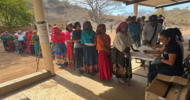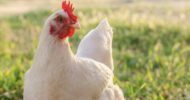Asia Sentinel | 01 August 2008
Brian McCartan
In its drive for food, China is planting deep roots in foreign fields
As other countries have pushed their industrial bases thousands of miles offshore in search of resources and labor, China is doing the same thing with agriculture, expanding as far away as Africa in its effort to feed its people. This is especially true in Southeast Asia, with its operations extending into Burma, Laos, the Philippines and Indonesia.
As evidence of the country’s growing unease over its ability to feed a population of 1.3 billion, China this week reversed its decade-long defense of free trade principles to join with Indian negotiators to derail the Doha Round of World Trade Organization negotiations. It insisted on safeguard rules for agriculture, and, according to the New York Times, sought to require that developing countries be allowed to impose prohibitively high tariffs on food imports from affluent countries to halt increases in imports that might put farmers in poor countries out of business.
China’s rise as an economic superpower has been at the cost of its traditional agricultural base. Annual gross domestic product growth of at least 6 percent since 1997 has fueled a shift in demographics that has moved millions of rural people off the farms and into the cities. Arable land is disappearing due to the construction of factories and homes, while desertification and pollution also shrink available agricultural tracts. China’s official Xinhua news agency reported in April 2007 that during the 2000-2005 five-year plan the country lost an average of 1.23 million hectares of land annually. Three million hectares of rice land were lost between 1996 and 2006.
The upshot is that China is finding it increasing difficult to feed the people while at the same time growing industrial crops for biofuels and rubber. Recognizing a need to conserve domestic food supplies, for the first time China made a pronounced shift in its economic policy in 2007 from net exporter to net importer of rice and wheat. Export tariffs on both staples were raised while import tariffs were removed to give easier access to the world market. Beijing is also strongly encouraging investment in overseas commercial agriculture projects to meet growing demands for food and raw materials. Chinese multinationals are involved in growing rice, corn, sugarcane, cassava and rubber, among other crops in Africa and even Cuba.
Accordingly, China is involved in an eight-year, 1 million-hectare operation in Indonesia’s Kalimantan state and in Papua New Guinea through China National Offshore Oil Corp (CNOOC), Indonesia's Sinar Mas Group, and Hong Kong Energy (Holdings) Ltd to plant oil palm, sugar and cassava.
This is not an easy path. As a strategist in Shanghai pointed out, “the best way to piss off people is to take their land.” In the Philippines, for instance, strong local objections from senators and farm groups appear to have stalled a plan, announced in January of 2007 by Agriculture Secretary Arthur Yap, under which Chinese companies would invest US$4.9 billion to fund projects that provide access to agricultural commodities. That would have included a US$3.83 billion investment by the Guangdong-based Fuhua Group over five to seven years to develop 1 million hectares of high yielding strains of corn, rice and sorghum, Yap said.
Nowhere is this outbound push for commodities more pronounced than in remote eastern Yunnan Province, where land transport is inconvenient and the search for agricultural supplies is patchy. While China’s cross-border investment in commercial agriculture is growing rapidly in neighboring Laos, albeit not without criticism, investment in Burma is limited by that country’s poor economic and agricultural policies.
A January 2008 report by the American Congressional Research Service said that China made pledges of trade and investment in Laos worth US$876 million in 2007. Direct Chinese investment in Laos was approved at US$1.1 billion by August 2007, according to the Lao Committee for Planning and Investment, making China the second largest investor in Laos after Thailand. Chinese agricultural investment is particularly strong in the northern provinces of Luang Nam Tha, Pongsali, Udomxai and Bokeo.
Agribusiness in northern Laos can be broken down into three general categories. First, there are individual farmers who seek their own markets, usually through relatives across the border in China, and take all the risk. The second method is through village-based farmers’ associations that share the cost of inputs and labor and divide the profits after the harvest. The third category is agribusiness companies working through contracts with individual farmers, associations or government concessions. Companies with large concessions usually obtain them through contacts with Lao district or provincial officials or through the Lao army.
Chinese companies provide seeds, fertilizers, pesticides and sometimes machinery, while local villagers provide the labor. The companies also provide technical support and one or more Chinese supervisors are generally on site. Concession fees are paid for the use of the land and profits are shared based on agreements signed with the companies.
Investment in rubber plantations is by far Laos’s largest commercial agriculture business. China has become the world’s largest consumer of rubber; by 2020 it is expected to consume a third of the world supply. By that time it is estimated there will be 200 million vehicles on Chinese roads. A source close to the rubber industry in Laos noted that of US$26 million invested by China in northwestern Laos, US$20 million was in rubber. In Luang Nam Tha province, more than 10,000 hectares has already been planted, an amount that continues to expand. Xinhua reported that some 35,100 hectares were planted in rubber in Laos for China. The government news agency noted that exports to China of US$54 million were expected to increase mainly due to rubber exports, with both countries seeking to increase trade to US$1 billion in the next few years.
Other crops grown under contract or concession arrangements are corn, bananas, cassava, agar wood and sugarcane. According to the Vientiane Times, Chinese investors in 2005 signed 15-year contracts to buy sugarcane from 40,000 hectares and cassava from 60,000 hectares of farmland in Luang Nam Tha province. A 2006 report by the Lao-Swedish Upland Agriculture and Forestry Research Program noted that 90 percent of Udomxai’s corn – its main cash crop – was destined for China. The same study said that 13,000 hectares had been planted in corn by 2006.
In 2007-2008 the amount of corn grown in the north increased by 35 percent, according to an individual closely involved in agricultural issues in Laos. Most of that is earmarked for China.
Critics of Chinese investment say that the unregulated nature of the system opens it to exploitation. Some northern farmers complain that their land has been expropriated and given to Chinese companies with little or no compensation, but this so far seems to be the exception rather than the rule, although several individuals knowledgeable about the area who spoke to Asia Sentinel said that the lack of a clear-cut land ownership law in Laos left open the potential for serious land conflicts due to land grabs by unscrupulous officials and businessmen.
Although analysts say the situation is improving somewhat, weak enforcement of environmental laws is also a concern as agricultural projects encroach on forest preserves. The central Lao government announced a moratorium on new land grants in 2007, but this has largely been ignored by provincial officials.
For the average Lao farmer, however, the possibility of increased earning has mitigated fears about doing business with their giant neighbor. Chinese-built roads also have increased access to markets in Yunnan. Previously most of the trade was conducted south over long and often poor mountain roads to Vientiane and Thailand. Farmers can earn as much as $1,200 per acre from rubber about seven times more than from rice.
In contrast, large-scale Chinese agricultural investment in Burma is plagued by economic mismanagement, poor agricultural policies and ethnic politics along the China-Burma border that have left many farmers worse off than before. Farmers in northern Burma, rather than benefiting from cross-border contacts have largely been forced to go it alone.
Although almost all seeds, fertilizers, pesticides and farm machinery come from China researchers in Burma’s northern Shan State and western Arakan State who recently returned from those areas, say farmers are forced to buy seeds and other inputs by government authorities and the military. This is often done in conjunction with decrees to plant a certain type of crop or to force farmers to plant two crops per year on land that can only sustain one.
China has become Burma’s second largest trading partner according to Xinhua. Bilateral trade between the two countries was $1.46 billion in 2006, with Yunnan accounting for $692.08 million. Border trade made up 82 percent of Burma’s exports to China in 2005. Those figures are likely low, however, since the junta rarely includes cross-border exports to China in its figures.
Rice is currently the largest agricultural export to China from the Shan State and will likely remain so. Environmental researchers say that the junta has been forcing villagers to plant hybrid rice seeds from China requiring much higher inputs of fertilizers and pesticides rather than indigenous seeds. They also note that without proper technical assistance local farmers are unable to get the proper yields and the program has not been as successful as hoped, despite the regime’s continued insistence on ordering the planting of the seeds.
NGO researchers claim that the hybrid rice has a different taste than the traditional variety and one that does not appeal to Burmese. In addition to purchasing the rice, the trucks transporting it are generally owned by Chinese as are the distributor companies. A close relationship has been established between the Burmese officers responsible for issuing business permits and Chinese businessmen giving them almost monopoly power over the marketplace and the distribution of farming supplies.
The high cost of the seeds that the farmers are forced to buy and of the pesticides and fertilizers they must use has forced many farmers deep into debt, the researchers say, forcing many farmers to sell their land, often to the same Chinese businesses who sold them the seeds, fertilizers and pesticides. The land is then often turned into commercial farms, assisted by Burmese officials keen to increase agricultural exports, but more often interested in making a profit for themselves off of concession fees and through the border trade.
Rice exports to China were halted in the wake of Cyclone Nargis by order of Northeast Regional Commander Major General Aung Than Htut in late May. Observers note, however, that this is a long-standing order which has been largely ignored and will likely be again once Burmese officials realize the shortfalls in profits from the loss of trade.
Other crops grown for export are maize, sunflower, oranges, tea and sugarcane. The Thai agribusiness giant Charoen Pokaphan Group, dominates the hybrid feed corn seed business in Burma with a 75 percent market share, but according to the United States Department of Agriculture, “feed corn from northern Shan State goes to China as well as one third of corn produced in Nan Sang township in southern Shan State.”
Ironically, in Kachin State, west of Shan State and also bordering China, Chinese fertilizers have contributed to a growing opium poppy crop in the past year along the border. According to the exiled media organization, Kachin News Group, many of these poppy fields are also owned by Chinese businessmen. This accusation has been echoed by human rights researchers from northern Shan State.
Burma’s complex ethnic politics have left large sections of the China-Burma border in the hands of ethnic insurgent armies. Although they currently have ceasefires with the military regime, there is little government influence in the areas they control. Chinese companies have invested in the area of the United Wa State Army (UWSA), the largest ethnic army in Burma and considered to be one of the largest narcotics producing organizations in the world. This investment has been encouraged by the Chinese government as a way of prodding the UWSA to give up cultivating opium, which it claims to have done in 2005.
Rubber has been the main investment in the UWSA area. Large-scale rubber plantations exist around the UWSA headquarters at Pangshang and the Shan Herald Agency for News (SHAN), an exile media organization, claims that 600,000 acres of Wa controlled territory have been planted in rubber. The group claims that two rubber factories have been set up in Namteuk and Pangshang on the border. About a dozen Chinese companies are reportedly involved in growing rubber with the Nong Chang Company from Yunnan the largest investor according to SHAN. Rubber plantation workers have been promised 60 percent of the profits once the trees begin producing. According to a researcher studying the area, this has already begun and China has promised to import rubber from the Wa tax free.
There is also some dissatisfaction among local farmers, who say that the policy to grow rubber has come down from the UWSA headquarters which makes the deals with the Chinese and they are not consulted. Farmers are simply told that they will now be growing rubber. The seven year period between planting and harvesting is a long time for farmers who until recently were growing opium poppies as a cash crop to buy food.
While the average Lao farmer may be wary but eager to do business, Chinese investment and its heavy handed encouragement by the Burmese regime seem to strengthen anti-Chinese feelings in the country, especially in the north. Although the Lao government has taken a largely hands-off approach to Chinese agricultural investment most analysts agree that the average Lao farmer stands to benefit from the investment.
In contrast, the Burmese government’s authoritarian approach only serves to enrich government officials and Burmese and Chinese businessmen at the cost of local farmers. Researchers in northern Burma make it clear that these policies are unsustainable and are impoverishing thousands of poor farmers. Chinese businesses may still benefit from the agricultural produce received, but surely it would be more efficient to have enthusiastic farmers who hope to make a profit, rather than farmers who can only envision a cycle of endless debt.
Brian McCartan
In its drive for food, China is planting deep roots in foreign fields
As other countries have pushed their industrial bases thousands of miles offshore in search of resources and labor, China is doing the same thing with agriculture, expanding as far away as Africa in its effort to feed its people. This is especially true in Southeast Asia, with its operations extending into Burma, Laos, the Philippines and Indonesia.
As evidence of the country’s growing unease over its ability to feed a population of 1.3 billion, China this week reversed its decade-long defense of free trade principles to join with Indian negotiators to derail the Doha Round of World Trade Organization negotiations. It insisted on safeguard rules for agriculture, and, according to the New York Times, sought to require that developing countries be allowed to impose prohibitively high tariffs on food imports from affluent countries to halt increases in imports that might put farmers in poor countries out of business.
China’s rise as an economic superpower has been at the cost of its traditional agricultural base. Annual gross domestic product growth of at least 6 percent since 1997 has fueled a shift in demographics that has moved millions of rural people off the farms and into the cities. Arable land is disappearing due to the construction of factories and homes, while desertification and pollution also shrink available agricultural tracts. China’s official Xinhua news agency reported in April 2007 that during the 2000-2005 five-year plan the country lost an average of 1.23 million hectares of land annually. Three million hectares of rice land were lost between 1996 and 2006.
The upshot is that China is finding it increasing difficult to feed the people while at the same time growing industrial crops for biofuels and rubber. Recognizing a need to conserve domestic food supplies, for the first time China made a pronounced shift in its economic policy in 2007 from net exporter to net importer of rice and wheat. Export tariffs on both staples were raised while import tariffs were removed to give easier access to the world market. Beijing is also strongly encouraging investment in overseas commercial agriculture projects to meet growing demands for food and raw materials. Chinese multinationals are involved in growing rice, corn, sugarcane, cassava and rubber, among other crops in Africa and even Cuba.
Accordingly, China is involved in an eight-year, 1 million-hectare operation in Indonesia’s Kalimantan state and in Papua New Guinea through China National Offshore Oil Corp (CNOOC), Indonesia's Sinar Mas Group, and Hong Kong Energy (Holdings) Ltd to plant oil palm, sugar and cassava.
This is not an easy path. As a strategist in Shanghai pointed out, “the best way to piss off people is to take their land.” In the Philippines, for instance, strong local objections from senators and farm groups appear to have stalled a plan, announced in January of 2007 by Agriculture Secretary Arthur Yap, under which Chinese companies would invest US$4.9 billion to fund projects that provide access to agricultural commodities. That would have included a US$3.83 billion investment by the Guangdong-based Fuhua Group over five to seven years to develop 1 million hectares of high yielding strains of corn, rice and sorghum, Yap said.
Nowhere is this outbound push for commodities more pronounced than in remote eastern Yunnan Province, where land transport is inconvenient and the search for agricultural supplies is patchy. While China’s cross-border investment in commercial agriculture is growing rapidly in neighboring Laos, albeit not without criticism, investment in Burma is limited by that country’s poor economic and agricultural policies.
A January 2008 report by the American Congressional Research Service said that China made pledges of trade and investment in Laos worth US$876 million in 2007. Direct Chinese investment in Laos was approved at US$1.1 billion by August 2007, according to the Lao Committee for Planning and Investment, making China the second largest investor in Laos after Thailand. Chinese agricultural investment is particularly strong in the northern provinces of Luang Nam Tha, Pongsali, Udomxai and Bokeo.
Agribusiness in northern Laos can be broken down into three general categories. First, there are individual farmers who seek their own markets, usually through relatives across the border in China, and take all the risk. The second method is through village-based farmers’ associations that share the cost of inputs and labor and divide the profits after the harvest. The third category is agribusiness companies working through contracts with individual farmers, associations or government concessions. Companies with large concessions usually obtain them through contacts with Lao district or provincial officials or through the Lao army.
Chinese companies provide seeds, fertilizers, pesticides and sometimes machinery, while local villagers provide the labor. The companies also provide technical support and one or more Chinese supervisors are generally on site. Concession fees are paid for the use of the land and profits are shared based on agreements signed with the companies.
Investment in rubber plantations is by far Laos’s largest commercial agriculture business. China has become the world’s largest consumer of rubber; by 2020 it is expected to consume a third of the world supply. By that time it is estimated there will be 200 million vehicles on Chinese roads. A source close to the rubber industry in Laos noted that of US$26 million invested by China in northwestern Laos, US$20 million was in rubber. In Luang Nam Tha province, more than 10,000 hectares has already been planted, an amount that continues to expand. Xinhua reported that some 35,100 hectares were planted in rubber in Laos for China. The government news agency noted that exports to China of US$54 million were expected to increase mainly due to rubber exports, with both countries seeking to increase trade to US$1 billion in the next few years.
Other crops grown under contract or concession arrangements are corn, bananas, cassava, agar wood and sugarcane. According to the Vientiane Times, Chinese investors in 2005 signed 15-year contracts to buy sugarcane from 40,000 hectares and cassava from 60,000 hectares of farmland in Luang Nam Tha province. A 2006 report by the Lao-Swedish Upland Agriculture and Forestry Research Program noted that 90 percent of Udomxai’s corn – its main cash crop – was destined for China. The same study said that 13,000 hectares had been planted in corn by 2006.
In 2007-2008 the amount of corn grown in the north increased by 35 percent, according to an individual closely involved in agricultural issues in Laos. Most of that is earmarked for China.
Critics of Chinese investment say that the unregulated nature of the system opens it to exploitation. Some northern farmers complain that their land has been expropriated and given to Chinese companies with little or no compensation, but this so far seems to be the exception rather than the rule, although several individuals knowledgeable about the area who spoke to Asia Sentinel said that the lack of a clear-cut land ownership law in Laos left open the potential for serious land conflicts due to land grabs by unscrupulous officials and businessmen.
Although analysts say the situation is improving somewhat, weak enforcement of environmental laws is also a concern as agricultural projects encroach on forest preserves. The central Lao government announced a moratorium on new land grants in 2007, but this has largely been ignored by provincial officials.
For the average Lao farmer, however, the possibility of increased earning has mitigated fears about doing business with their giant neighbor. Chinese-built roads also have increased access to markets in Yunnan. Previously most of the trade was conducted south over long and often poor mountain roads to Vientiane and Thailand. Farmers can earn as much as $1,200 per acre from rubber about seven times more than from rice.
In contrast, large-scale Chinese agricultural investment in Burma is plagued by economic mismanagement, poor agricultural policies and ethnic politics along the China-Burma border that have left many farmers worse off than before. Farmers in northern Burma, rather than benefiting from cross-border contacts have largely been forced to go it alone.
Although almost all seeds, fertilizers, pesticides and farm machinery come from China researchers in Burma’s northern Shan State and western Arakan State who recently returned from those areas, say farmers are forced to buy seeds and other inputs by government authorities and the military. This is often done in conjunction with decrees to plant a certain type of crop or to force farmers to plant two crops per year on land that can only sustain one.
China has become Burma’s second largest trading partner according to Xinhua. Bilateral trade between the two countries was $1.46 billion in 2006, with Yunnan accounting for $692.08 million. Border trade made up 82 percent of Burma’s exports to China in 2005. Those figures are likely low, however, since the junta rarely includes cross-border exports to China in its figures.
Rice is currently the largest agricultural export to China from the Shan State and will likely remain so. Environmental researchers say that the junta has been forcing villagers to plant hybrid rice seeds from China requiring much higher inputs of fertilizers and pesticides rather than indigenous seeds. They also note that without proper technical assistance local farmers are unable to get the proper yields and the program has not been as successful as hoped, despite the regime’s continued insistence on ordering the planting of the seeds.
NGO researchers claim that the hybrid rice has a different taste than the traditional variety and one that does not appeal to Burmese. In addition to purchasing the rice, the trucks transporting it are generally owned by Chinese as are the distributor companies. A close relationship has been established between the Burmese officers responsible for issuing business permits and Chinese businessmen giving them almost monopoly power over the marketplace and the distribution of farming supplies.
The high cost of the seeds that the farmers are forced to buy and of the pesticides and fertilizers they must use has forced many farmers deep into debt, the researchers say, forcing many farmers to sell their land, often to the same Chinese businesses who sold them the seeds, fertilizers and pesticides. The land is then often turned into commercial farms, assisted by Burmese officials keen to increase agricultural exports, but more often interested in making a profit for themselves off of concession fees and through the border trade.
Rice exports to China were halted in the wake of Cyclone Nargis by order of Northeast Regional Commander Major General Aung Than Htut in late May. Observers note, however, that this is a long-standing order which has been largely ignored and will likely be again once Burmese officials realize the shortfalls in profits from the loss of trade.
Other crops grown for export are maize, sunflower, oranges, tea and sugarcane. The Thai agribusiness giant Charoen Pokaphan Group, dominates the hybrid feed corn seed business in Burma with a 75 percent market share, but according to the United States Department of Agriculture, “feed corn from northern Shan State goes to China as well as one third of corn produced in Nan Sang township in southern Shan State.”
Ironically, in Kachin State, west of Shan State and also bordering China, Chinese fertilizers have contributed to a growing opium poppy crop in the past year along the border. According to the exiled media organization, Kachin News Group, many of these poppy fields are also owned by Chinese businessmen. This accusation has been echoed by human rights researchers from northern Shan State.
Burma’s complex ethnic politics have left large sections of the China-Burma border in the hands of ethnic insurgent armies. Although they currently have ceasefires with the military regime, there is little government influence in the areas they control. Chinese companies have invested in the area of the United Wa State Army (UWSA), the largest ethnic army in Burma and considered to be one of the largest narcotics producing organizations in the world. This investment has been encouraged by the Chinese government as a way of prodding the UWSA to give up cultivating opium, which it claims to have done in 2005.
Rubber has been the main investment in the UWSA area. Large-scale rubber plantations exist around the UWSA headquarters at Pangshang and the Shan Herald Agency for News (SHAN), an exile media organization, claims that 600,000 acres of Wa controlled territory have been planted in rubber. The group claims that two rubber factories have been set up in Namteuk and Pangshang on the border. About a dozen Chinese companies are reportedly involved in growing rubber with the Nong Chang Company from Yunnan the largest investor according to SHAN. Rubber plantation workers have been promised 60 percent of the profits once the trees begin producing. According to a researcher studying the area, this has already begun and China has promised to import rubber from the Wa tax free.
There is also some dissatisfaction among local farmers, who say that the policy to grow rubber has come down from the UWSA headquarters which makes the deals with the Chinese and they are not consulted. Farmers are simply told that they will now be growing rubber. The seven year period between planting and harvesting is a long time for farmers who until recently were growing opium poppies as a cash crop to buy food.
While the average Lao farmer may be wary but eager to do business, Chinese investment and its heavy handed encouragement by the Burmese regime seem to strengthen anti-Chinese feelings in the country, especially in the north. Although the Lao government has taken a largely hands-off approach to Chinese agricultural investment most analysts agree that the average Lao farmer stands to benefit from the investment.
In contrast, the Burmese government’s authoritarian approach only serves to enrich government officials and Burmese and Chinese businessmen at the cost of local farmers. Researchers in northern Burma make it clear that these policies are unsustainable and are impoverishing thousands of poor farmers. Chinese businesses may still benefit from the agricultural produce received, but surely it would be more efficient to have enthusiastic farmers who hope to make a profit, rather than farmers who can only envision a cycle of endless debt.













